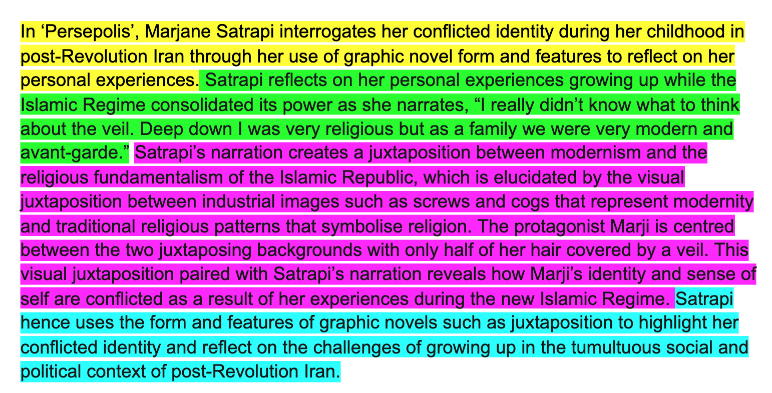
Are you struggling to organise your essay’s body paragraphs? Have you heard of the PEEL paragraph structure but are unsure of how to use it effectively? Look no further! In this comprehensive guide, we will walk you through the art of writing PEEL paragraphs, enabling you to excel in your essay writing endeavours.
Table of Contents
Understanding the PEEL Paragraph Structure
What is PEEL?
PEEL is an acronym that stands for Point, Example, Explain, and Link. It is a widely used writing structure that helps you organise your thoughts and present a clear and concise argument in each paragraph.
- P = Point: Start with a clear and specific point that you want to make in the paragraph.
- E = Example: Provide an example or evidence to support your point.
- E = Explain: Explain how the example or evidence supports your point and provide insightful analysis.
- L = Link: Connect your paragraph to the previous and next paragraphs, ensuring a smooth transition and logical flow.
As your writing becomes more advanced, you may find yourself using additional E’s in your PEEL paragraphs, such as Explore, Elaborate, or Evaluate. However, for the purpose of this guide, we will focus on the basic PEEL structure.
Why Should You Use PEEL Paragraphs?
Using the PEEL structure in your paragraphs will provide your essay:
- Clarity: The PEEL structure ensures that each paragraph focuses on a single argument, making your writing clear and concise.
- Convincing Arguments: By incorporating evidence and explanations in your paragraphs, you can build strong and persuasive arguments.
- Logical Flow: The use of the PEEL structure helps create a logical flow between paragraphs, making it easier for readers to follow your thoughts.
Now that we understand the importance of using PEEL paragraphs, let’s explore each component in detail.
Crafting Strong Points
The most important part of the PEEL writing system is getting your point across from the beginning. The first sentence, acting as the topic sentence, introduces the reader to your topic and briefly states your stance. It’s crucial to be clear because this is when the reader first interacts with your point. Including irrelevant information at the start can prevent you from addressing important things in the rest of your paragraph, and that can work against you.
Remember, the topic sentence sets the tone for the entire paragraph, so invest time and effort in crafting it effectively.
Backing Your Claims
To make your arguments persuasive and compelling, it is crucial to incorporate evidence into your PEEL paragraphs. Evidence can come in various forms, including:
- Facts and Statistics: Use factual information and statistics to support your claims and make them more credible.
- Expert Opinions: Include quotes or opinions from experts in the field to strengthen your argument and demonstrate your engagement with relevant sources.
- Examples and Case Studies: Provide real-life examples or case studies that illustrate your point and make it more relatable to the reader.
By incorporating evidence, you give your arguments substance and make them more convincing to your audience.
Explaining the Why
You have made your point and provided evidence; now, it’s time to explain what it all means. In persuasive writing, there is usually a call to action, meaning something the writer wants the reader to do. In a PEEL essay, the call to action is to inform the reader and make them agree with your point. The explanation is where you have the most influence on the reader. Clearly explain how your evidence supports your point, leaving no doubt about why you are right.
Building Bridges
Linking is a way to smoothly move from one idea to the next in your essay. It might be tricky to introduce a new idea as you finish talking about the last one, but it keeps your essay organised. After you have finished one point and are ready to talk about something else, find a way to connect the two. Is there something they have in common? If not, it might mean there is something missing or you need to rearrange your points. Thinking about how your points connect before you start writing helps you create a clear and non-confusing essay.
PEEL Paragraph Example
Each component of PEEL has been highlighted for your convenience, Point (yellow), Example (green), Explanation (purple), Link (blue).
Advantages of Using PEEL Paragraph Writing
Using the PEEL paragraph structure offers several advantages for your writing:
- Improved Organisation: The PEEL structure helps you logically organise your ideas and arguments, ensuring a clear and coherent essay structure.
- Enhanced Clarity: By focusing on a single argument in each paragraph, you provide clarity and avoid confusion for your readers.
- Stronger Arguments: Incorporating evidence and explanations in your PEEL paragraphs strengthens your arguments and makes them more persuasive.
- Engaging Writing: The use of the PEEL structure creates a flow in your essay, keeping your readers engaged and interested in your ideas.
Conclusion
In conclusion, understanding how to write PEEL paragraphs is crucial for crafting well-structured and persuasive essays. The PEEL structure allows you to present your arguments effectively, provide supporting evidence, and explain the importance of your points.
If you are struggling to organise your essay or afraid that you will not be able to submit your essays before the deadline then get in touch with Assignment Studio. Our expert essay writers will help you with your essay and make sure that you received a perfect essay that will receive a perfect grade!








